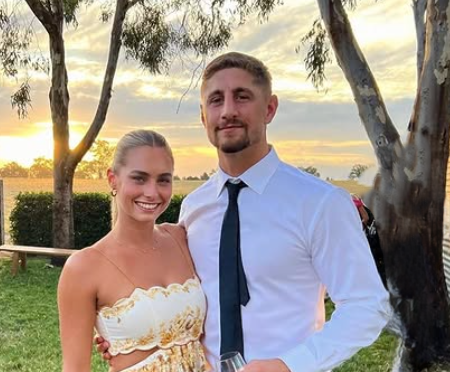In addition to being physically dominant and intensely motivated on the rugby field, Zac Lomax has a personal life that keeps fans and the media interested. The young Parramatta Eels winger is viewed through a different prism with every relationship that emerges or disappears, exposing a complex story that goes beyond his 80-minute games.

His understated yet eye-catching Instagram debut with Tahlia Thornton sparked new rumors in recent months. The couple’s relaxed photo, taken atop Diamond Head in Hawaii, suggested more than just a vacation; it conveyed a peaceful assurance in their relationship. Recent national championships saw Thornton, a rising star in Australian swimming, place fourth in the 200-meter backstroke and sixth in the 100-meter backstroke. She held Olympic hopes for Paris 2024 with incredible intensity at the age of 19.
Zac Lomax Personal and Relationship Overview
| Attribute | Detail |
|---|---|
| Full Name | Zac Lomax |
| Birth Date | 24 September 1999 |
| Birthplace | Temora, New South Wales, Australia |
| Height | 190 cm (6 ft 3 in) |
| Weight | 105 kg (16 st 7 lb) |
| Playing Positions | Centre, Wing |
| Current Club | Parramatta Eels (National Rugby League) |
| Past Club | St George Illawarra Dragons |
| National Representation | New South Wales (State of Origin), Australia |
| Former Partner | Jessica Sergis (NRLW Star) |
| Latest Known Partner | Tahlia Thornton (Swimmer, Australian A Team) |
| Relationship Status | Reportedly single post-Thornton split |
| Public Reveal Moment | Instagram post from Hawaii alongside Tahlia Thornton |
| Notable Interaction | Playful Instagram banter with swimmer Kyle Chalmers about fashion and hiking gear |
| Reference Link | NRL.com Player Profile |
The 26-year-old Lomax, who is already an experienced NRL professional, has continuously attracted notice for both his polished off-field manner and his intense on-field play. It felt especially appropriate to link up with Thornton, a young athlete who was just as committed to her craft. Without the necessity for an interview or headline, they skillfully incorporated their relationship into the public discourse by posting their vacation moment online. The picture was sufficient.
Thornton’s essay served as a virtual press release thanks to well-timed and implicit clues. Olympic swimmer Kyle Chalmers was among the many commenters who made fun of Lomax’s rucksack by implying that he was carrying her possessions. Lomax drew fans into their dynamic by shooting back with equal gusto, never one to duck friendly fire. An otherwise carefully planned look into their personal life was made more charming and spontaneous by their discussion.
For NRL fans, this was more than just another couple’s revelation; it represented a new phase in Lomax’s developing public persona. Although it ended with both of them purging social media of any shared moments, his prior relationship with Jessica Sergis had been as well-known. The milder attitude with Thornton was a stark contrast to their breakup. This change in tone points to personal development and possibly a better comprehension of how to strike a balance between one’s private life and public life.
Lomax and Thornton’s brief romance served as a reminder to viewers that emotional engagement is still crucial in high-stakes situations, particularly in professional sports where rigorous training schedules, travel, and media commitments sometimes strain interpersonal relationships. Finding a common rhythm outside of their careers can be just as difficult for athletes balancing Olympic qualifying and premiership campaigns as their physical disciplines.
Notably, Thornton has maintained her swimming emphasis. Her selection for the Australian A squad and her performance at national championships put her squarely in the sights of sponsors and selectors. When she represented the nation at the US nationals in July, she kept a low profile, was subtly reliable, and advanced very quickly. Although her attendance at Dragons games earlier in the year had drawn criticism, her goals were still very much in the open—Paris 2024 was undoubtedly her goal.
In contrast, Lomax had a strong season with the Dragons in 2022, participating in 24 games and earning 167 points. His individual statistics demonstrated his dependability even though the squad missed the finals and finished in eighth place. His recent transfer to the Parramatta Eels heralds a new era and higher hopes. The adjustment might work incredibly well for a player whose style blends flare and grit.
Even though it is reportedly no longer active, the relationship with Thornton gives his character depth. Even though their collaboration was short, it focused on themes of respect for one another and athletic aspirations. By collaborating with Thornton—self-reliant, gifted, and ambitious—Lomax reiterated a set of principles that go far beyond the allure of stardom. It’s a pattern noticed among athletes who gravitate toward partners that understand the unique pressures of their careers.
The fact that social media still serves as the main source of confirmation or conjecture is especially intriguing. A single photo posted online might serve as a farewell, a timestamp, or a declaration. The Hawaii post was the first—and perhaps last—digital chapter for Thornton and Lomax. No long caption. No group interviews. Just a single, nicely shot picture with some playful remarks.
The quiet between them seems to say a lot these days as Thornton intensifies her Olympic aspirations and Lomax returns to his NRL career. Just as there was no official notification of a beginning, there is no need to announce closure. It’s a contemporary relationship arc based on timing, mutual respect, and the knowledge that long-term relationships may not always be as important as personal development.
From this angle, their brief romance emphasizes the extraordinarily demanding nature of professional sports life rather than signifying failure. Relationships turn into their own training grounds, putting emotional intelligence, patience, and resilience to the test. Athletes like Thornton and Lomax frequently have to decide between friendship and professional advancement, and this choice might change from season to season.
It’s simple to overlook the more subdued layers underlying these linkages while the general public observes and responds. On a trek, carrying someone else’s bag turns becomes a considerate act. A shared photo in Hawaii becomes a memory recorded in pixels. Modern athlete relationships are shaped by these subtle cues—present participles that convey emotional weight—far more so than by large-scale public displays.
Through the use of a visual narrative, Lomax and Thornton were able to maintain interest while preserving their uniqueness. Their brief alliance nevertheless endures in the public consciousness when they reappear as distinct forces in sport—not for controversy or spectacle, but rather for the sincerity of its purpose.











